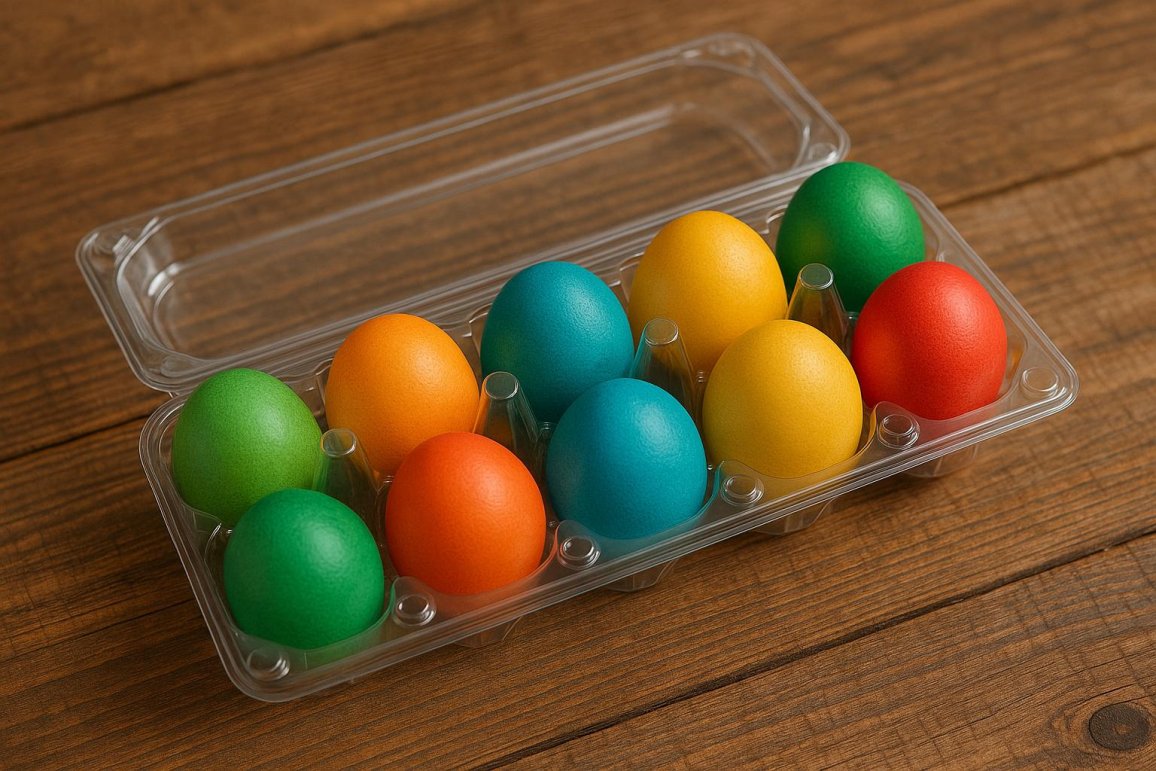With Easter eggs, it’s the packaging that counts
Easter time is egg time. And for those who want to place them safely in the nest, egg packaging made of 100 percent recycled plastic is the best choice for purchase and storage: Compared to cardboard boxes, the lightweight plastic containers offer greater stability and are more resistant to moisture. Their smooth surface also reduces the attack surface for germs. The packaging also allows a direct view of the condition of the goods. In addition, plastic packaging can be produced in an energy-efficient way and recycled after use.

Plastic egg packaging – more hygienic, more stable and with a clear view of the goods.
Significant difference
The brightly coloured eggs at Easter are traditionally used to celebrate spring, life and renewal. In other words, everything that plastic also stands for: lightness, ecology and recycling. A conventional, grey 10-piece egg carton made of cardboard weighs about 45-50 grams, the plastic alternative is almost 40 percent lighter. With around 13.1 billion eggs produced annually in this country and packed in about 1 billion egg cartons, depending on the stocking, this has an immense impact: The difference in weight of the two packages leads to a difference in the total load of about 20,000 tons - the equivalent of almost 3,000 trucks. Due to the twice as high stacking density when transporting the empty egg packages, an additional 3,000 truck trips per year can be avoided. These transports, which are saved by plastic packaging, save a lot of energy and reduce CO₂ emissions.
Cardboard boxes: Complex process
The production of cardboard egg cartons is also anything but easy. Even the recycling of waste paper is a complex process: collected paper must be sorted, then cleaned using mechanical and chemical processes. The waste paper is then dissolved and processed into a stable fibre web. The overall process requires a lot of water, energy and technical precision. Depending on requirements, the finished cardboard is additionally coated and printed. According to estimates, around 10 to 20 percent of new paper made from fresh wood is also used. Not really an ecological system, because the production of virgin fibre paper requires an average of about 50,000 litres of water per tonne to go with the felled trees – which is why the Nature and Biodiversity Conservation Union (NABU) has been explaining for years that paper production pollutes the environment and nature. When using egg packaging made of 100 percent recycled plastic (rPET), 84 percent less water and about 26 percent less energy are required.
Packaging as a valuable material
Used egg cartons cannot always be recycled and returned to the material cycle – if an egg breaks, which is often the case with cardboard, the packaging has to be disposed of in the residual waste instead of in the waste paper. Clean plastic containers or those that have been cleaned of dirt, on the other hand, can be recycled up to 100 percent. In addition, more and more plastic packaging is made from recycled material (rPET), which further improves its environmental footprint.
Less resource consumption
Plastic packaging is resistant and less susceptible to the penetration of dirt and liquids. This increases the protection of the products and extends their shelf life. In addition, transparent plastic containers immediately show whether the eggs are intact. If an egg is damaged, the plastic packaging prevents leakage and protects other containers and, depending on the packaging design, the other eggs from contamination. An important advantage – for example, the Austrian specialist for transparent egg packaging "Ovotherm" points out that 40 to 50 times more resources are needed to produce 10 eggs than to produce their packaging. A broken egg can be found in both paper and plastic packaging. The fundamental difference is that due to the leaked liquid, the packaging underneath is not soiled and can be sold. If an egg breaks in a cardboard package, up to 19 undamaged eggs must be disposed of. In addition, the environmental impact of only two damaged eggs out of 100 packaged eggs is just as high as the burden of packaging all 100 eggs.
Plastic protects better
The higher resistance of plastic packaging to moisture is an essential hygiene factor: While the porous structure of the cardboard absorbs moisture and thus provides a favourable environment for microorganisms, plastic surfaces are smoother and less permeable, making it more difficult for bacteria to survive. Therefore, the risk of germ transmission tends to be higher with egg packaging made of cardboard than with those made of plastic. According to Ökotest, many consumers are not aware that egg cartons can be harmful to health.
Background: The eggs are only roughly cleaned before packaging, which is why there is a risk that pathogens will stick to the shells and transfer to the carton. Salmonella, which causes severe gastrointestinal diseases, is particularly dangerous. Therefore, according to the German Food Hygiene Ordinance, food must be protected from any contamination during storage. For this reason, it is also strongly advised against using used egg cartons, as cardboard cannot be cleaned, unlike plastic containers.
Do you like our texts? Perhaps even so much that you want to use them in your own media? Then please get in touch with us beforehand!
